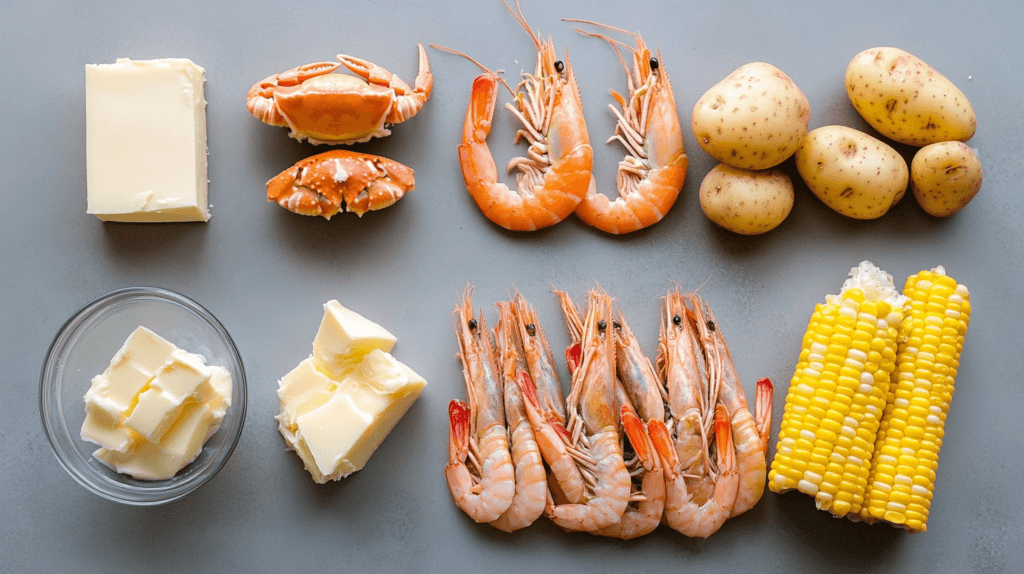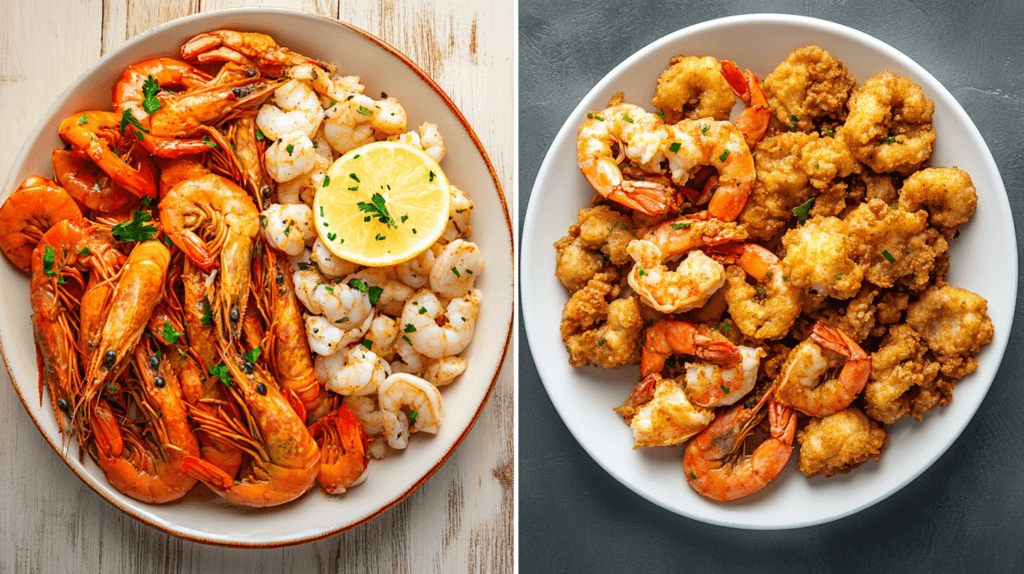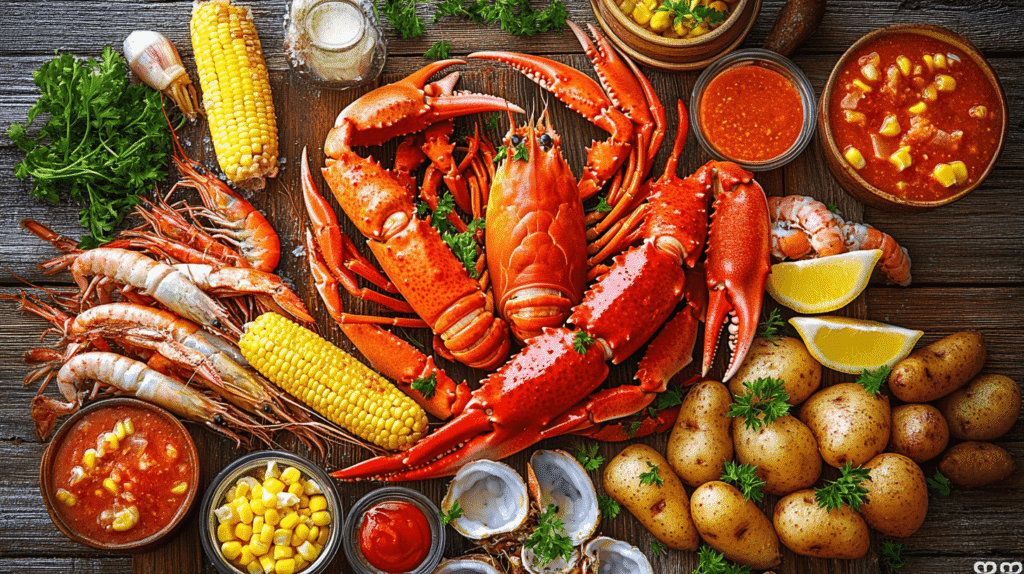Seafood boils have become a favorite meal for many, thanks to their delicious combination of flavors and the communal style of eating. Whether you’re attending a backyard party, a beach gathering, or dining at a seafood restaurant, seafood boils are a popular choice. But have you ever wondered how many calories are in a seafood boil? Understanding the calorie content can help you enjoy this delectable feast while staying mindful of your health and fitness goals.
Seafood boils typically include a mix of seafood, vegetables, and flavorful spices, often paired with rich sauces and sides. While they can be a nutrient-packed option, the calorie count depends on the ingredients and preparation methods used. In this guide, we’ll explore the calorie content of common seafood boil ingredients, popular variations, and tips for reducing calorie intake while savoring every bite.
Table of Contents
What Is a Seafood Boil?
Definition and Cultural Significance
A seafood boil is a hearty meal that combines various types of seafood, such as shrimp, crab, and lobster, with vegetables like corn and potatoes. These ingredients are boiled together in a pot of seasoned water, creating a flavorful, aromatic dish. Seafood boils are often served in large gatherings, making them a symbol of celebration and togetherness.
Regional Variations of Seafood Boils and Their Calories
Seafood boils vary across regions, each with its unique twist:
- Cajun-Style Seafood Boil: Known for its spicy, robust flavors, this style often includes andouille sausage, shrimp, and crawfish, cooked with Cajun spices.
- Low-Country Boil: Popular in the southeastern United States, this variation includes shrimp, sausage, potatoes, and corn, with Old Bay seasoning.
- Asian-Influenced Seafood Boil: Incorporates ingredients like garlic butter sauce, chili paste, and even lemongrass for a distinctive taste.
Typical Ingredients in a Seafood Boil and Their Calories Impact
Most seafood boils consist of:
- Seafood: Shrimp, crab, lobster, crawfish, mussels, or clams.
- Vegetables: Corn on the cob, red potatoes, and sometimes onions.
- Seasonings: Cajun spices, garlic, butter, and hot sauce.
- Extras: Sausages, boiled eggs, and dipping sauces like garlic butter or aioli.
Calories in Common Seafood Boil Ingredients

Seafood is the star of the dish, and its calorie content varies depending on the type:
- Shrimp (100g): 99 calories
- Crab (100g): 87 calories
- Lobster (100g): 89 calories
- Mussels (100g): 86 calories
- Clams (100g): 74 calories
Seafood is generally low in calories and rich in protein, making it a healthy choice.
Vegetables
Vegetables add texture and nutrition but can contribute to the calorie count:
- Corn on the Cob (1 ear): 77 calories
- Red Potatoes (100g): 87 calories
These starchy additions are filling but can increase the overall calorie total, especially if served in large quantities.
Sausages and Meats
Sausages are a flavorful addition but can be high in calories:
- Andouille Sausage (100g): 297 calories
- Smoked Sausage (100g): 281 calories
Seasonings and Sauces
Butter and sauces significantly impact the calorie count:
- Butter Sauce (1 tbsp): 102 calories
- Garlic Butter Sauce (1 tbsp): 130 calories
- Cajun Seasoning (1 tbsp): 20 calories
The type and amount of sauce used can drastically change the calorie content of the dish.
Serving Size and Portion Control for a Seafood Boil
How Serving Size Impacts the Calories in a Seafood Boil
The calorie count of a seafood boil depends largely on portion size. A typical serving of a seafood boil might include:
- 150g of seafood
- 1 ear of corn
- 100g of potatoes
- 50g of sausage
This combination could range from 500 to 800 calories, depending on the specific ingredients and sauces.
how many calories are in a seafood boil?
On average, a serving of seafood boil without excessive butter or heavy sauces contains 500-600 calories. However, adding rich sauces can increase this to 700-900 calories per serving.
Cooking Methods and Their Impact on the Calories in a Seafood Boil

Boiling vs. Frying: How It Affects Calorie Count
The way you prepare your seafood boil can significantly affect its calorie content. Boiling, the traditional cooking method, is one of the healthiest ways to prepare this dish since it doesn’t involve added fats. The ingredients are cooked in water or broth infused with seasonings, keeping the calorie count lower.
In contrast, frying seafood adds calories due to the absorption of oil during the cooking process. For example:
- Boiled Shrimp (100g): 99 calories
- Fried Shrimp (100g): 277 calories
Choosing boiled over fried seafood can save hundreds of calories in a single meal.
The Role of Added Fats Like Butter or Oils
While boiling itself doesn’t add calories, the sauces served with seafood boils often do. Garlic butter sauce, for example, can quickly increase the calorie count. Here’s a comparison:
- Seafood Boil with Butter Sauce: 700-900 calories per serving
- Seafood Boil with Light Seasoning (No Butter): 500-600 calories per serving
To reduce calorie intake, consider limiting the amount of butter or using healthier alternatives like olive oil or lemon juice.
Health Benefits and Calories in a Seafood Boil
Nutritional Value of Seafood
Seafood is a powerhouse of nutrients, offering high-quality protein, omega-3 fatty acids, and essential vitamins. These nutrients provide several health benefits:
- Omega-3 Fatty Acids: Promote heart and brain health.
- Protein: Supports muscle growth and repair.
- Vitamins and Minerals: Zinc, selenium, and vitamin B12 boost immunity and energy levels.
Vitamins and Minerals in Accompanying Vegetables
The vegetables in a seafood boil add fiber, vitamins, and minerals. For example:
- Corn on the Cob: Rich in fiber and vitamin C.
- Potatoes: A good source of potassium and vitamin B6.
Including a variety of vegetables enhances the dish’s nutritional profile.
Potential Downsides: Sodium and Cholesterol
Despite its benefits, a seafood boil can be high in sodium and cholesterol. Here’s why:
- Sodium: Cajun seasonings, butter, and seafood can all contribute to high sodium levels, which may not be suitable for individuals with hypertension.
- Cholesterol: Some seafood like shrimp and crab contains moderate amounts of cholesterol.
Balancing your portion sizes and using low-sodium seasonings can help mitigate these downsides.
Popular Variations and Their Calorie Counts
Cajun-Style Seafood Boil
A Cajun seafood boil is known for its spicy kick and robust flavors. A typical serving includes shrimp, crawfish, sausage, corn, and potatoes, with Cajun seasoning and butter. Calories per serving: 700-900.
Low-Country Boil
The Low-Country boil, often associated with the Carolinas and Georgia, includes shrimp, smoked sausage, corn, and red potatoes. It’s seasoned with Old Bay and served with cocktail sauce. Calories per serving: 600-800.
Asian-Influenced Seafood Boil
Asian-style seafood boils feature seafood cooked with garlic butter, chili paste, soy sauce, and spices. They may also include rice or noodles as a side. Calories per serving: 800-1,000.
Tips for Reducing Calories in a Seafood Boil
Substituting Ingredients
- Choose Leaner Meats: Replace sausage with turkey or chicken sausage.
- Reduce Starchy Vegetables: Swap potatoes with zucchini or cauliflower.
- Use Healthier Sauces: Opt for olive oil and lemon instead of butter-heavy sauces.
Cooking Techniques
- Steam Instead of Boil: Steaming preserves nutrients while keeping calories low.
- Avoid Frying: Stick to boiling or grilling to minimize calorie intake.
Portion Control Strategies
- Serve Smaller Portions: Use smaller bowls or plates to control serving size.
- Limit Sauces: Serve sauces on the side to control the amount used.
- Balance the Meal: Add a fresh salad or steamed vegetables to reduce reliance on starchy sides.
How to Estimate Calories in a Homemade Seafood Boil
Creating a seafood boil at home allows you to control the ingredients and portion sizes, making it easier to estimate the calorie count. Here’s a step-by-step guide to accurately calculate the calories in your homemade seafood boil:
1. Tracking Ingredients and Portion Sizes
The first step is to list all the ingredients you plan to use and weigh them accurately. Each ingredient contributes a specific number of calories based on its weight. Here’s an example:
- Shrimp (150g): ~148 calories
- Crab (200g): ~174 calories
- Corn (1 ear): ~77 calories
- Potatoes (200g): ~174 calories
- Butter (2 tbsp): ~204 calories
- Garlic Butter Sauce (1 tbsp): ~130 calories
Total Estimated Calories: 907 calories
Use nutritional labels or an online database to get accurate calorie counts for each item.
2. Calculating Calories for Sauces and Seasonings
Sauces and seasonings often account for hidden calories in a seafood boil. For example:
- Butter Sauce: ~102 calories per tablespoon
- Olive Oil (if used): ~119 calories per tablespoon
- Cajun Seasoning: ~20 calories per tablespoon
If you’re making your own sauce, add up the calories of each ingredient, such as garlic, butter, lemon juice, and spices.
3. Using Online Tools and Apps
Digital tools and apps like MyFitnessPal or Cronometer can simplify calorie tracking. These tools allow you to enter each ingredient and its weight, providing a comprehensive breakdown of the total calorie count.
4. Estimating Calories Per Serving
Once you have the total calorie count for the entire boil, divide it by the number of servings. For instance, if your seafood boil has 2,400 calories and serves six people, each serving is approximately 400 calories.
5. Adjusting for Cooking Methods
Cooking methods like boiling and steaming typically don’t add calories, but if you fry or sauté ingredients, you’ll need to factor in the added fat. For example:
- 1 tbsp of oil (for frying): ~119 calories
To keep the calorie count accurate, avoid discarding broth or butter sauce in your calculations if you plan to consume it.orie count.
How Many Calories Are in a Restaurant-Style Seafood Boil?
When dining out, estimating calories in a restaurant-style seafood boil can be more challenging due to larger portions, added butter, and rich sauces. Here’s how you can approach it:
1. Understanding Portion Sizes
Restaurant seafood boils often include generous portions of seafood, vegetables, and sausages. A typical serving might include:
- Seafood (200g): 174 calories
- Corn (2 ears): 154 calories
- Potatoes (300g): 261 calories
- Butter Sauce (3 tbsp): 306 calories
- Sausage (100g): 297 calories
Estimated Calories Per Serving: ~1,200 calories
2. Hidden Calories in Sauces and Sides
Restaurants commonly use sauces like garlic butter, aioli, or spicy mayo, which can add significant calories. For instance:
- Garlic Butter Sauce (3 tbsp): ~390 calories
- Spicy Mayo (2 tbsp): ~200 calories
Ask for sauces on the side to control how much you use, potentially saving hundreds of calories.
3. Factors Influencing Calorie Counts
Several factors can impact the calorie count of a restaurant-style seafood boil:
- Cooking Oils: Some restaurants add oil to the boil for extra flavor, which increases the calorie count.
- Extra Ingredients: Boiled eggs, additional sausage, or extra corn can add calories.
- Seasonings: While seasonings like Old Bay or Cajun spices are low in calories, their salt content may contribute to water retention, making the dish feel heavier.
4. Tips for Reducing Calories When Dining Out
To enjoy a seafood boil at a restaurant without overindulging:
- Request No Butter: Ask for the boil to be prepared without butter or heavy sauces.
- Choose Lean Proteins: Stick to shrimp, crab, or mussels, which are lower in calories.
- Control Portion Sizes: Consider sharing a large portion with others or packing leftovers.
- Skip Extra Sides: Avoid ordering calorie-heavy sides like bread or fries.
5. Average Calorie Range for Restaurant Seafood Boils
Depending on the restaurant and portion size, a seafood boil can range from 800 to 1,500 calories per serving. Asking for nutritional information (if available) or observing portion sizes can help you make an informed decision.
By following these guidelines, you can better estimate the calories in both homemade and restaurant-style seafood boils, making it easier to enjoy this flavorful dish while staying mindful of your dietary goals.
Frequently Asked Questions (FAQs)
Are Seafood Boils Healthy?
Yes, seafood boils can be healthy when prepared with the right ingredients and methods. They are rich in protein, omega-3 fatty acids, and essential vitamins and minerals. However, their healthiness depends on portion sizes and the amount of butter, salt, and other calorie-dense additions used.
What’s the Lowest-Calorie Seafood Option?
Among seafood choices, clams and mussels are the lowest in calories, with about 74–86 calories per 100 grams. Shrimp and crab are also relatively low-calorie options. Opting for these can help keep the overall calorie count of your seafood boil low.
Do Sauces Add a Lot of Calories?
Absolutely. Sauces like garlic butter significantly increase the calorie count. Consider using lighter sauces like this crab boil sauce or limiting the amount used.
Can I Make a Seafood Boil Keto-Friendly?
Absolutely! To make a seafood boil keto-friendly, skip the starchy vegetables like potatoes and corn, and instead include non-starchy vegetables such as zucchini or broccoli. Use butter or olive oil liberally, as they are keto-friendly fats.
How Does Alcohol Pair with Seafood Boils?
Many enjoy pairing beer or wine with seafood boils, but alcohol adds extra calories. For example:
- Beer (12 oz): ~150 calories
- Wine (5 oz): ~120 calories
Opt for light beers or smaller portions to minimize the calorie addition.
What’s a Typical Serving Size for a Seafood Boil?
A typical serving size for a seafood boil includes approximately:
- 150g of seafood
- 1 ear of corn
- 100g of potatoes
- 50g of sausage
This serving ranges between 500 and 800 calories, depending on the sauce and preparation.
Conclusion
Seafood boils are a flavorful and nutrient-rich meal that can fit into a healthy diet with the right approach. While the calorie content can vary depending on the ingredients and preparation, understanding the breakdown of each component can help you enjoy this dish responsibly. For a healthier option, try lighter sauces like this crab boil sauce or learn how to thicken seafood boil sauce to maintain flavor without excessive calories.
With mindful choices and portion control, seafood boils can be a delicious and satisfying option for all. Whether you’re hosting a party or enjoying a cozy dinner, this iconic dish allows you to indulge while staying true to your health goals. So, go ahead—savor every bite of this delightful meal!

